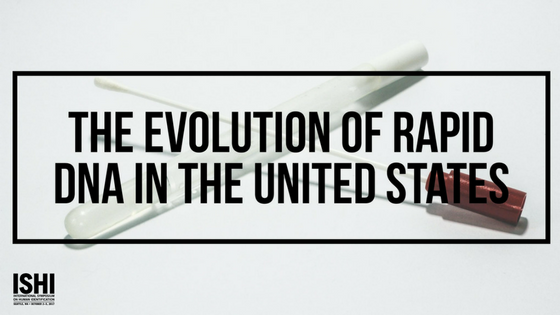Ever since FBI Director Comey told the United States Senate Judiciary Committee that Rapid DNA would “change the world in a very, very exciting way,” integration of the technology into the arrestee booking process has become a question of when rather than if, with momentum building daily.
Submitted by: Kevin Babak, IntegenX
Rapid DNA, defined as the hands-free process of developing a DNA profile from a reference buccal swab in under two hours, has wide-ranging implications for the fields of forensic DNA and criminal investigation. In the 30 states which have laws requiring collection of a suspect’s cheek swab upon felony arrest, the time elapsed from sample collection to database upload and hit notification is rarely less than four weeks, and often the process takes months.
As a result, even in the states with the quickest turnaround time, an arrestee may only be connected to an unsolved crime after being released on bail—a chilling prospect considering that the DNA of approximately 3% of arrestees can be linked to unsolved crimes. In California, where roughly 10,000 reference profiles are uploaded to the CODIS database each month, 300 potentially dangerous criminals may be given the chance to commit additional crimes, or flee the jurisdiction, while their DNA sample is processed, amounting to thousands of criminals going free each year. Rapid DNA addresses the issue by enabling an arrestee’s DNA to be tested and searched against databases within hours of arrest, so that the result may be reviewed while the suspect is still in police custody.
Legislative Climate
Although commercially available Rapid DNA systems have been demonstrated to work with certain non-reference samples, the experts in the field, the advocacy groups representing victims and practitioners alike, and the legislation working its way through the federal government are currently focused on the use of Rapid DNA for reference samples only.
The Rapid DNA Acts of 2015 and 2016 were introduced in the US House of Representatives and the US Senate in January 2015 and December 2015, respectively. The legislation modifies the DNA Identification Act of 1994, which requires that all DNA profiles uploaded to CODIS be generated in accredited laboratories. Under the Rapid DNA Act, profiles generated in booking stations on FBI-approved Rapid DNA devices may also be uploaded to the national database.
The first groups to support the legislation were victims’ advocacy organizations (National Center for Victims of Crime, Hope Exists after Rape Trauma, Natasha’s Justice Project), followed by organizations representing practitioners such as the Consortium of Forensic Science Organizations and the National District Attorneys Association, and lastly law enforcement representatives such as the International Association of Chiefs of Police, the Major Cities Chiefs Association, and the Association of State Criminal Investigation Agencies.
While each of these organizations is national in scope, groups representing Law Enforcement Agencies in California and Florida—the states with the largest arrestee databases in the country—have also publicly supported the legislation. As a result of the broad-based, bi-partisan support for Rapid DNA legislation, the Senate passed their version of the Rapid DNA Act (S.2348) by unanimous consent in June of this year, and the House Judiciary Committee marked up the legislation favorably in July.
The next step along the path towards becoming law is a vote in the House of Representatives, after which the bill will be sent to the President for signature. This could occur between now and the inauguration of the next president.
Looking Forward
Four trends will define the evolution of Rapid DNA over the next two years: First, the trend towards lower cost of Rapid DNA instrumentation and DNA profile acquisition will allow adoption of the technology to follow a path similar to that of Livescan—eventually there will be a Rapid DNA instrument in every booking station in the country. Dramatic reduction in the cost structure of owning and operating Rapid DNA technology can already be seen in the commercialization of IntegenX’s second generation Rapid DNA System, the RapidHIT® ID, which is approximately half the cost per instrument and per sample compared to IntegenX’s RapidHIT 200.
Second, several high-profile implementations by foreign law enforcement agencies—in countries where the legislative climate already allows DNA testing in the booking station—will drive adoption of Rapid DNA in the United States. Once there are concrete demonstrations of how much value the technology brings to law enforcement and, by proxy, to society, the need to implement it will rise.
Third, the increasing number of large-scale implementations will drive costs down further through economies of scale, allowing Rapid DNA profiles to be delivered at a cost similar to that of the benchtop methods, at the same time eliminating inefficiencies associated with shipping samples from every corner of a particular state to the central laboratory.
Finally, wide-spread use and acceptance of Rapid DNA for reference buccal swabs will open the door for testing a subset of crime scene samples with the technology (eg, those samples which are presumed to be single source and high enough in quantity that a second sample may be analyzed by conventional methods if the Rapid DNA analysis is unsuccessful). Together, these trends will define the development of Rapid DNA across the next two years, ultimately leading to a reduction in crime driven by better harnessing the investigative power of DNA.
About the Author
Kevin Bebak is the Global Marketing Manager at IntegenX, the market leader in Rapid DNA technology. Kevin has worked with national police forces, forensic labs, and militaries in over 10 countries to implement Rapid DNA programs.
WOULD YOU LIKE TO SEE MORE ARTICLES LIKE THIS? SUBSCRIBE TO THE ISHI BLOG BELOW!


